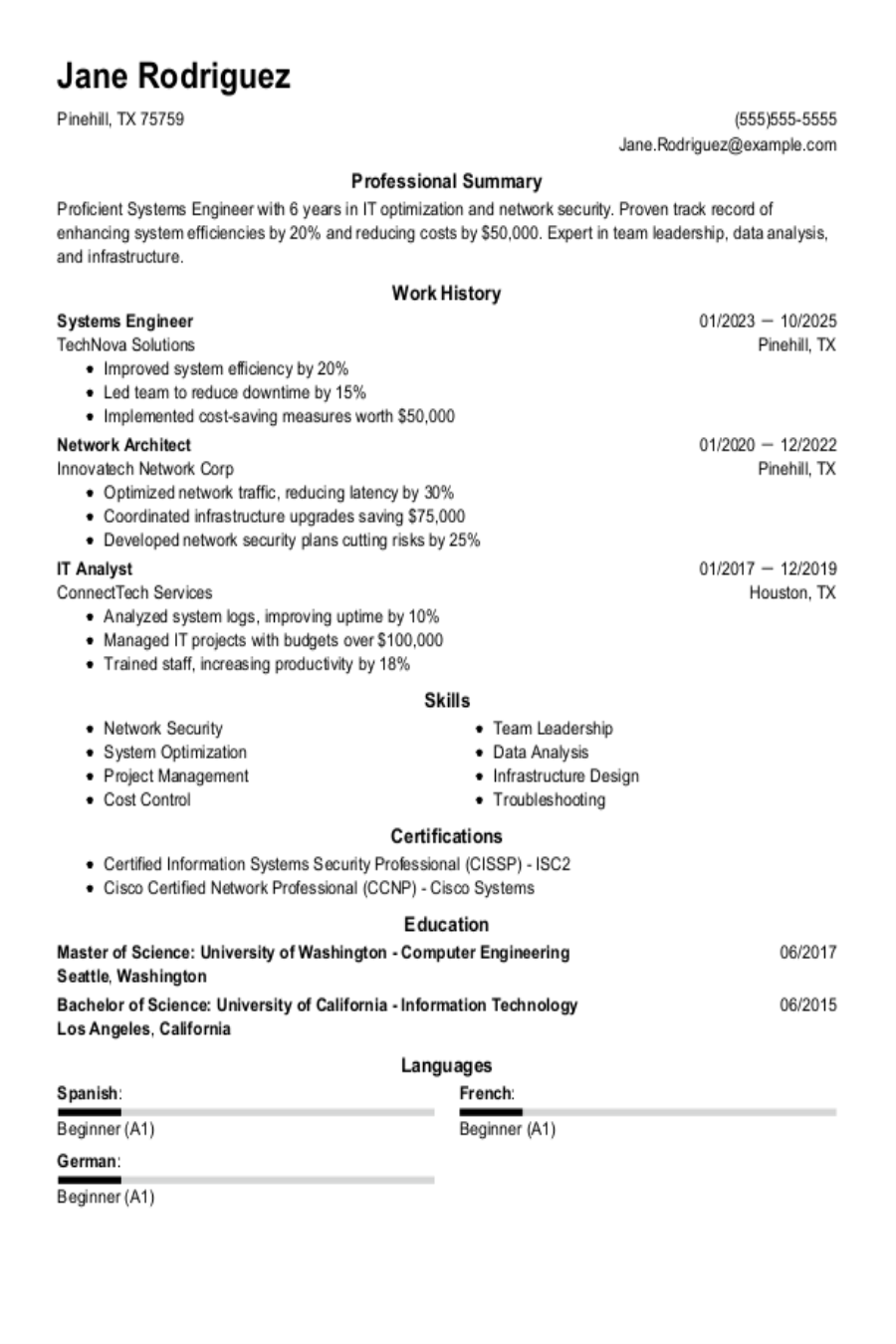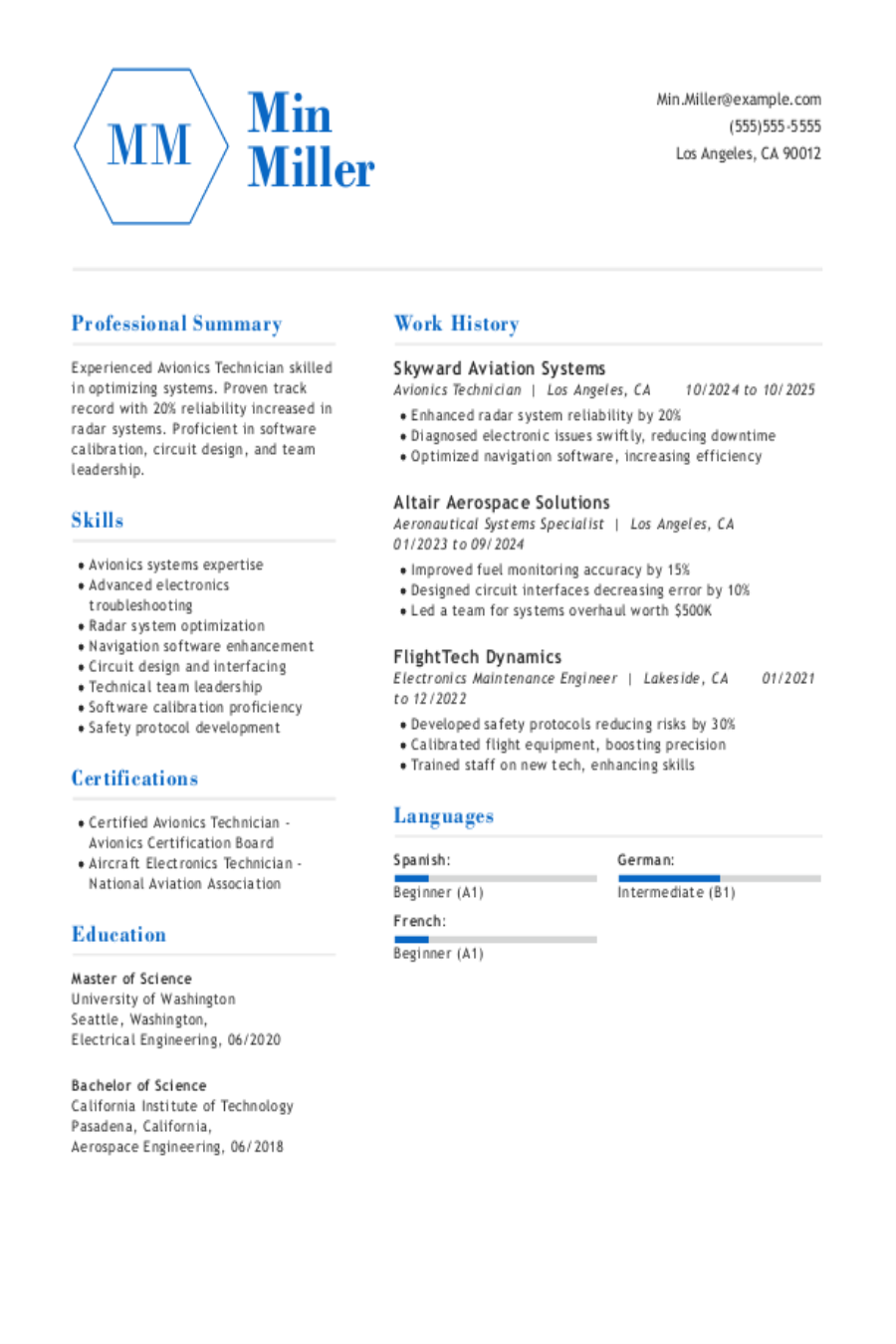Popular Business Analyst Resume Examples
Entry-level business analyst resume
An entry-level resume for a business analyst should emphasize relevant academic projects, internships, technical skills in data analysis, and strong problem-solving abilities to show potential despite limited experience.
Emphasizes skills: This resume effectively highlights the job seeker's strong analytical and project management skills, which compensate for limited hands-on experience.
Focuses on goals: The job seeker demonstrates strong potential as a business analyst by applying analytical skills in data-driven projects and earning relevant certifications, reflecting a commitment to continuous learning and professional development.
Mid-career business analyst resume
A mid-career business analyst resume should emphasize a strong combination of analytical skills, project experience, and continuous professional development to effectively demonstrate capability and growth in driving business solutions.
Displays qualifications neatly: A well-structured resume improves clarity, allowing recruiters to quickly identify key skills and accomplishments.
Opens with a succinct professional summary: A strong professional summary highlights key qualifications such as expertise in data analysis and process optimization, making it easy for recruiters and ATS to swiftly recognize the applicant's relevant experience.
Experienced business analyst resume
An experienced business analyst resume should highlight key achievements and skills, clearly illustrating the applicant's career growth and contributions to projects in a straightforward manner that emphasizes value to potential employers.
Uses a traditional resume format: The chronological resume format clearly presents the extensive experience of the job seeker, allowing them to demonstrate their career progression and showcase their achievements over time.
Embraces a modern resume style: This modern resume template effectively showcases the applicant's analytical expertise and strategic mindset, reinforcing their innovative approach and commitment to driving business solutions.
No experience business analyst resume
A resume for an applicant with no experience should highlight relevant skills, educational background, and any projects or internships that demonstrate analytical abilities and problem-solving capabilities.
Volunteer work: Without any concrete work experience, this business analyst resume is supported by the candidate's volunteer work and extracurricular activities.
Accomplishments: This resume ends with an accomplishments section that reinforces the candidate's capabilities by highlighting academic achievements and community participation.
More resume examples
Business Analyst Resume Template
Kickstart your career journey with this versatile business analyst resume template. Easily tailor it to reflect your unique skills and experiences for maximum impact.
Daniel Liu
Brookfield, WI 53016
(555)555-5555
Daniel.Liu@example.com
Professional Summary
Dynamic Business Analyst with 5 years experience, expert in data analysis, process improvement, and market research to drive strategies.
Work History
Business Analyst
Strategic Insights Group - Brookfield, WI
September 2023 - September 2025
- Increased efficiency by 20% via process improvements
- Developed reports leading to a 15% cost reduction
- Conducted market analysis improving sales by 0K
Data Analyst
Insightful Analytics Co. - Milwaukee, WI
May 2022 - August 2023
- Streamlined data workflows reducing errors by 30%
- Analyzed data trends increasing revenue by 0K
- Automated reports saving 10 hours weekly
Junior Analyst
Data Solutions Network - Milwaukee, WI
September 2020 - April 2022
- Assisted in project planning with M budget
- Improved data accuracy by 25% through audits
- Collaborated on cross-functional team projects
Skills
- Data Analysis
- Market Research
- Process Improvement
- SQL
- Python
- Financial Analysis
- Critical Thinking
- Business Strategy
Education
Master of Business Administration Business Analytics
University of Washington Seattle, Washington
June 2020
Bachelor of Science Economics
California State University Los Angeles, California
June 2018
Certifications
- Certified Business Analyst Professional - International Institute of Business Analysis
- Data Analytics Certificate - Google
Languages
- Spanish - Beginner (A1)
- French - Beginner (A1)
- German - Beginner (A1)
Must-Have Skills on a Business Analyst Resume
A strong skills section can significantly improve your resume, showcasing your abilities to potential employers.
Project and process management professionals ensure initiatives move forward smoothly and systems function effectively. The skills you highlight should reflect your role in supporting goals and maintaining momentum. You resume is an opportunity to demonstrate how you help create order and drive successful outcomes.
The following data outlines the most prevalent hard and soft skills for a business analyst according to Resume Now’s internal resume data.
When you're ready to refine your skills list, try using our AI Resume Skills Generator. It offers tailored suggestions based on your job title, helping you create a comprehensive and personalized skill set.
Writing Your Business Analyst Resume
Having explored these exemplary resumes, you're now well-equipped to dive into the resume writing journey. In the following sections, we'll guide you step by step through how to write a resume that showcases your skills and experience effectively.
List your most relevant skills
A strong skills section on your business analyst resume should highlight both technical skills, such as data analysis and requirement gathering, as well as essential soft skills like communication and critical thinking. By carefully reviewing keywords from the job listing, you can extract relevant terms that reflect the specific competencies employers are looking for.
Incorporating these keywords into your skills section not only helps you resonate with human recruiters but also optimizes your chances of passing through applicant tracking systems (ATS). When you align your presented abilities with the language found in job descriptions, you're effectively demonstrating that you meet their criteria.
Example of skills on a business analyst resume
- Proficient in analyzing business requirements and translating them into actionable insights
- Experienced in using data visualization tools to present findings effectively
- Strong communicator with the ability to collaborate cross-functionally
- Adept at identifying process improvements and implementing solutions
Highlighting your soft skills on your resume can set you apart from other applicants. Employers often prioritize interpersonal abilities, as they are challenging to develop and essential for fostering collaboration and a positive workplace culture.
Highlight your work history
Your work experience section should highlight your accomplishments and illustrate how you’ve applied analytical skills in various scenarios. Focus on specific achievements that demonstrate your contributions to projects or processes, ensuring you use relevant keywords to capture the interest of hiring managers.
When describing each job entry, include essential details like your job title, employer’s name, and dates of employment. Providing this context helps employers understand your professional journey more clearly. Additionally, consider incorporating metrics or measurable outcomes from your work to showcase the impact you made within those roles.
Example of a business analyst work experience entry
- Business Analyst
Tech Solutions Inc. - San Francisco, CA
March 2021 - Present - Conduct comprehensive data analysis to identify trends and insights, resulting in a 15% increase in operational efficiency
- Collaborate with cross-functional teams to define project requirements and deliver actionable solutions, improving product development timelines by 25%
- Facilitate stakeholder meetings to gather feedback and align on project objectives, ensuring a consistent understanding of business needs
- Develop detailed documentation and reports that communicate findings clearly to both technical and non-technical audiences, improving decision-making processes
- Train junior analysts on best practices for data interpretation and presentation skills, fostering a culture of continuous improvement within the team
In your resume, aim for concise bullet points that highlight key achievements. Focus on specific results and quantifiable metrics to demonstrate your impact, ensuring each point is informative without being overly lengthy. This balance will keep your resume engaging and effective.
Include your education
The education section of your business analyst resume should be organized in reverse-chronological order, starting with your most recent degree. If you have a college degree, you can leave out your high school diploma. Including relevant certifications, such as Certified Business Analysis Professional (CBAP) or Agile Analysis Certification (AAC), can further improve this section by showcasing your qualifications.
If your education is ongoing or incomplete, mention the highest level attained and include an expected graduation date. For those who are current students or have recently graduated, listing relevant coursework and academic accomplishments in bullet points can effectively highlight your skills and knowledge relevant to the role of a business analyst.
Common certifications for a business analyst resume
- Certified Business Analysis Professional (CBAP) – International Institute of Business Analysis (IIBA)
- Certification in Business Data Analytics (CBDA) – International Institute of Business Analysis (IIBA)
- PMI Professional in Business Analysis (PMI-PBA) – Project Management Institute (PMI)
- Agile Analysis Certification (AAC) – International Institute of Business Analysis (IIBA)
Sum up your resume with an introduction
Your resume profile serves as your first opportunity to capture the attention of potential employers. It provides a snapshot of your professional identity and sets the tone for the rest of your application.
For experienced applicants, a professional summary is ideal because it allows you to showcase your notable accomplishments right at the top of your resume. By detailing specific successes and areas of expertise, you enable hiring managers to quickly gauge how you can contribute to their organization. Candidates with less experience should open with a resume objective that concisely indicates your goals and career development progress.
Professional summary example
Analytical business analyst with over 6 years of experience in harnessing data-driven insights for strategic decision-making in dynamic corporate environments. Proven expertise in requirements gathering, process optimization, and stakeholder engagement, leading to improved operational efficiency and significant cost savings. Adept at using advanced analytical tools and methodologies to drive compelling business solutions.
Resume objective example
Enthusiastic business analyst eager to use strong analytical skills and attention to detail in a collaborative environment. Aiming to support data-driven decision-making and improve operational efficiency through effective communication and problem-solving abilities while contributing to innovative solutions for the organization.
As a business analyst applicant, it's important to ensure your resume profile is succinct and powerful. Aim for three sentences that capture only the most important information about your skills and experience. If you have more to share, reserve those details for your cover letter, where you can elaborate further on your qualifications and achievements.
Add unique sections to set you apart
Optional resume sections can significantly improve your application as a business analyst, allowing you to showcase your unique qualifications beyond just work experience and education.
Including relevant hobbies and volunteer work in your resume can highlight the skills and values that align with the business analyst role. For instance, if you engage in data analysis projects during your free time or participate in community service that emphasizes problem-solving, it demonstrates not only your passion for analytics but also your commitment to making a positive impact.
Three sections perfect for a business analyst resume
- Languages: As a business analyst, effective communication with stakeholders is important. Highlighting your language skills on your resume can improve collaboration and facilitate clearer understanding in diverse teams, making you a more competitive applicant.
- Volunteer Work: Including volunteer work on a resume can improve your professional skills and showcase your dedication to community service. It demonstrates your commitment to helping others while highlighting valuable traits like teamwork and leadership.
- Accomplishments: As a business analyst, quantifiable accomplishments are important for demonstrating your impact on decision-making. Weave important metrics into your work history bullet points or create a unique section to showcase them.
5 Resume Formatting Tips
- Choose a format that matches your career stage.
Selecting the appropriate resume format is key to presenting your skills effectively. For an experienced business analyst, a chronological format can highlight career progression. If you're just beginning your career, a functional resume focuses on relevant skills rather than work history. Those with mixed experience might benefit from a combination resume that showcases both skills and job history. Choose the format that best reflects your unique journey.
- Pick a smart resume template.
Selecting a professional resume template is important for crafting a clear and organized document that stands out to employers. A well-structured template improves readability, enabling hiring managers to swiftly understand your qualifications. When choosing a custom format, keep it simple and select fonts that are easily readable by applicant tracking systems (ATS).
- Select an appropriate font.
Opt for a clean, professional font to improve your resume's readability. Fonts like Helvetica, Garamond, or Verdana are excellent choices, ensuring clarity for both applicant tracking systems and hiring managers alike. A well-chosen font can make your resume stand out in a competitive job market.
- Use consistent formatting.
Ensure your resume features uniform left alignment and margins to improve readability and convey a polished, professional image to potential employers.
- Keep your resume to one or two pages.
When crafting your resume, keep in mind that resumes should be one page long, especially if you're early in your career. Be concise and focus on your most relevant experiences to make a strong impression without overwhelming the reader. If you have extensive experience, a two-page format is acceptable, but clarity is key.
Tools for Your Job Search
Are you preparing to apply for that business analyst position you've been eyeing? Before submitting your application, consider leveraging our ATS Resume Checker. This invaluable tool offers insights into how well your resume will perform with the automated systems many companies use to filter job seekers during the initial screening process.
Need more robust support for your resume? Our AI Resume Builder is designed just for you, providing tailored recommendations based on your specific business analysis skills and experience. With professionally crafted templates at your disposal, you can ensure that your qualifications stand out to hiring managers.
Frequently Asked Questions
Last Updated: September 19, 2025
Absolutely. A cover letter is important as it adds depth to your resume and provides a chance for you to connect with employers on a personal level. It allows you to express your enthusiasm for the role and clarify how your skills make you an ideal job seeker. So, don’t overlook this important step—write a cover letter that highlights your unique qualifications.
For an easy and efficient way to create your cover letter, consider using our AI Cover Letter Generator. In just minutes, you can produce a personalized cover letter tailored to the job you're applying for. Plus, you'll find various cover letter template options that align perfectly with your resume, ensuring consistency throughout your application materials.
A resume is typically concise, spanning one to two pages, while a CV (curriculum vitae) can extend several pages and includes comprehensive details about your academic background, research accomplishments, and professional experiences. This means that if you're applying for positions that require in-depth qualifications and achievements, consider using a CV.
You should opt for a CV when applying for roles in academia or specialized fields such as law or medicine. If you need to create a tailored CV quickly, the online CV Maker is an excellent resource. With various CV templates suited for different industries and career levels, you can craft a stunning document in just minutes.
For a business analyst, a resume should ideally be one page long, providing a concise overview of your skills and experiences. However, if you have extensive experience or accomplishments to showcase, a two-page resume can be appropriate. Tailor the length to highlight your qualifications effectively while ensuring clarity and relevance for potential employers.
When addressing gaps on your resume, be honest about the reason for the time away from work. Highlight any productive activities you engaged in during that period, whether it was volunteering, coursework, or personal projects. This approach demonstrates your commitment to growth. After explaining the gap, steer the focus back to your relevant qualifications and experience to reassure potential employers of your capabilities.
To improve your networking skills as a business analyst, regularly connect with former colleagues to share insights and opportunities. Joining relevant professional organizations can significantly expand your network. Additionally, maintaining an updated LinkedIn profile is important for staying informed about industry trends and connecting with other professionals in your field.
To ace your business analyst interview, practice job interview questions and answers. This preparation boosts your confidence and equips you to handle any surprises that may come your way. Remember, being ready is key to showcasing your skills effectively.
Was this information helpful? Let us know!
Leisha is a career industry editor dedicated to helping job seekers excel in their careers.
More resources

Resume Now Spotlights 14 High-Innovation, High-Growth Jobs That Pay $60K+
Resume Now s latest report highlights some of the highest payi...

Bad Cover Letter Examples: How To Fix Those Annoying Mistakes
Check out four sample cover letters and then learn from a pro...
![Communication Skills for Your Resume [40+ Examples and How to Improve Them] Communication Skills for Your Resume [40+ Examples and How to Improve Them]](/sapp/uploads/2025/08/Communication-skills.png)
Communication Skills for Your Resume [40+ Examples and How to Improve Them]
Good communication skills can propel your personal and profess...

Systems Engineer Resume: Examples, Templates & Tips for 2025
Was this information helpful? Let us know ...



